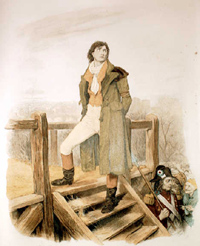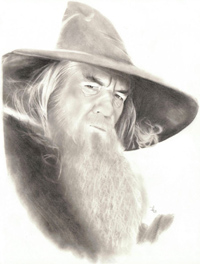I’ve been thinking about the question of what makes a good fictional character, and the result is this list of ways characters can draw readers’ interests, which I hope you’ll find useful.
There seem to be some basic requirements for characters that aren’t as much about drawing readers to them as about the character being workable at all, things like having flaws, actively pursuing goals, being vulnerable in some way, and being believable (at least in the context of the story). My list below is not so much about these things, which we might consider the character basics, but about the more difficult and touchy job of creating a character that pops off the page or that readers love.
With that said, my fictional success isn’t yet to the point where I can claim that all of my characters do this, so certainly you can take this list with a grain of salt.
So what I came up with when I dug into this question was five categories of things that get and keep readers interested in a character. They aren’t entirely exclusive of one another, but they seem to be helpful categories. They are:
1. sympathy (we like the character)
2. attention (we want to see what the character will do next)
3. entertainment (we enjoy seeing the character in action)
4. admiration (we aspire to be like the character), and
5. identification (we feel like the character reflects ourselves)
It’s likely that there are some other methods or even an entire category or two I’ve missed, but this list should be useful at least as a starting point.
By the way, I give a character for each of the below as an example of that item, but I’m not suggesting that the item in question is the only or even necessarily the primary thing that’s interesting about that particular character, just that the character is an example of that item in action.
 SYMPATHY
SYMPATHY
* Suffering through something undeserved (Harry Potter in Harry Potter and the Sorcerer’s Stone)
* Makes a sacrifice for someone else’s good (Sydney Carton in A Tale of Two Cities)
* Consistently kind to others even when mistreated (Little Orphan Annie in the Little Orphan Annie comic, etc.)
* Extremely loyal (Sam Gamgee in The Lord of the Rings)
* Highly principled (Atticus Finch in To Kill a Mockingbird)
* Not consistently nice, but sometimes willing to put real effort into being kind or friendly (Greg House in the TV series House)
 ATTENTION
ATTENTION
* Mysterious (Lestat in Interview with the Vampire)
* Trying really hard to accomplish something difficult (Hazel in Watership Down)
* Extremely resourceful, whether well-intentioned or not (Tom Sawyer in Tom Sawyer)
* Unique, fascinating, or exotic (Iorek Byrnison, the armored bear in The Golden Compass)
* Very powerful, whether in politics, money, physical prowess, etc. (Darth Vader in Star Wars)
 ENTERTAINMENT
ENTERTAINMENT
* Eccentric, unpredictable, fun to watch (Captain Jack Sparrow in Pirates of the Carribean)
* Willing to say things most people would only think (Sherlock Holmes in the modern movie and TV adaptations–I can’t comment on the originals, not having read them for a long time)
* Witty or intentionally entertaining (Bartimaeus in The Amulet of Samarkand)
* Strongly identifiable and partly–but not entirely–predictable (Homer Simpson in the TV series The Simpsons)
 ADMIRATION
ADMIRATION
* Great at something (Zorro in various movies)
* Wise or knowledgeable (Gandalf in The Lord of the Rings)
* Unflappable; impossible to keep down (Lyra in The Golden Compass)
IDENTIFICATION
* Struggling with issues we can identify with, whether successful or not (Holden Caulfield in The Catcher in the Rye)
* Feels like a stand-in for the reader (Bella Swan in Twilight)
Of course, many of the best characters hit multiple points above.
As an exercise, it can be useful to think of a character you love from a book, movie, or television show, consider whether one or more of the above applies strongly to that character, and decide for yourself whether or not that has much to do with why you like the character. Recently I’ve been watching the excellent BBC series Masterpiece: Downton Abbey, and I was interested to realize that as I made this list, various characters from that show popped into my head without me even trying.
A more potent exercise: take a piece of your writing–or even someone else’s writing–in which there’s a character who doesn’t really stand out, and go through this list to find one or two of the above items that you can use to punch the character up. What are your results?
I’d appreciate your comments, additions, protests, and so on.



